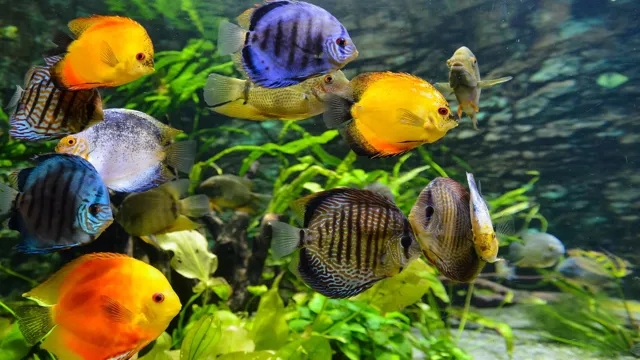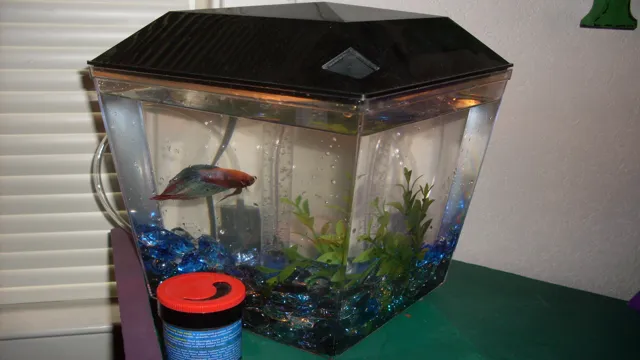How to Add Fish to Freshwater Aquarium: A Step-by-Step Guide for Beginners

Adding fish to a freshwater aquarium can be an exciting and fascinating experience. It’s like a blank canvas ready to be colored with different types of fish, each with its unique set of characteristics. However, it’s essential to do it right; otherwise, it could lead to stressing out and endangering the fish.
There are various factors to consider when adding fish to an aquarium, such as the size of the aquarium, water conditions, and compatibility between different species of fish. It might seem overwhelming at first, but fear not, this guide will cover everything you need to know to add fish to your freshwater aquarium without any consequences. From selecting the right fish to acclimating them to the tank’s conditions, we will guide you every step of the way.
So let’s dive into it and learn how to add fish to a freshwater aquarium correctly!
Prepare your Aquarium
If you’ve finally decided to add fish to your freshwater aquarium, there are a few steps you need to take to get your tank ready. Firstly, make sure the water conditions are suitable for your fish. Test the pH, nitrates, and ammonia levels to ensure they’re within the appropriate range.
Next, acclimate your fish to the new environment. This means slowly introducing them to the water in your tank, so they can adjust to the temperature and chemical makeup of their new home. Finally, be sure to add a good quality water conditioner to remove any toxins and ensure the water is safe for your fish.
With these steps in place, your fish will have a smooth transition into their new aquatic home. Remember to keep monitoring the water conditions and performing regular maintenance to keep your fish happy and healthy.
Clean and Cycle Your Aquarium
Before introducing any fish to your aquarium, it is crucial to properly clean and cycle it. The first step is to thoroughly clean all aquarium equipment, including the tank, gravel, decorations, and filter. Be sure to avoid using soap or any cleaning agents that could harm your fish.
Once cleaned, fill the tank with dechlorinated water and allow it to sit for at least 24 hours, testing the water parameters regularly. This process, known as cycling, allows beneficial bacteria to grow and establish a healthy environment for your fish. Adding live plants and a small number of fish can also help kickstart the cycling process.
It is important to be patient during the cycling period, as it could take several weeks to fully establish the proper water conditions. By taking the time to properly prepare your aquarium, you can ensure a healthy and thriving environment for your fish to call home.

Test Water Quality
When it comes to maintaining a healthy aquarium, testing the water quality is a crucial step. Before introducing any fish or other aquatic creatures into your tank, you’ll want to ensure that the water conditions are just right. This means testing for various factors such as pH levels, ammonia, nitrate, and nitrite levels.
You can purchase a water testing kit that includes strips that turn different colors to indicate the levels of these factors. It may take some trial and error to get everything just right, but taking the time to test and adjust the water quality will help ensure that your aquarium inhabitants thrive. By regularly monitoring and adjusting the water condition, you can provide a happy and healthy environment for your fish to live in.
Choose the Right Fish
When adding fish to your freshwater aquarium, it’s important to consider which fish will thrive in your specific tank environment. Choosing the right fish can make all the difference in the success of your aquarium. Research the different species and their ideal tank conditions such as temperature, pH level, and water hardness.
You’ll also want to consider the fish’s behavior and temperament, making sure they won’t harm or dominate other fish in the tank. Don’t forget to also think about their size and potential growth, as overcrowding can cause stress and disease. By carefully selecting the right fish for your aquarium, you can create a harmonious and thriving underwater community.
Research Fish Compatibility
Fish compatibility is an important factor to consider when setting up an aquarium. It’s essential to choose fish that can coexist peacefully with each other and won’t harm or stress each other out. At first, it may seem overwhelming, but researching fish compatibility can make sure that you choose the right fish for your tank.
Some fish are more aggressive, while some are peaceful and happy in shoals. Researching each fish you want to add to your tank is crucial, as it can prevent aggression, injury, and even death. For example, you wouldn’t want to put a small, docile fish with a predator that will view it as prey.
Water parameters like temperature, pH, and water hardness might also be considered when choosing compatible fish to avoid any health issues such as stress or disease. With the right knowledge and a little research, you can choose the right fish for your aquarium, ensuring that they will coexist peacefully while keeping the environment healthy.
Select Appropriate Size and Quantity
When selecting fish for your aquarium, it’s essential to choose the right size and quantity to ensure they thrive. It’s important to research the specific needs of the fish you’re interested in and determine how many can comfortably live in your tank. Overcrowding can lead to stress, disease, and even death.
Equally important is selecting fish that are compatible with each other, as some species may be aggressive towards others. Additionally, consider the size of the fish when purchasing. Although they may appear small in the store, some fish can grow quite large and require a larger tank as they mature.
Taking the time to plan and research your fish selection will help you create a beautiful and healthy aquarium for all to enjoy.
Acclimate Your Fish
Adding new fish to a freshwater aquarium can be exciting, but it’s important to acclimate them properly to avoid stress or even death. Start by floating the bag with the fish in the aquarium for about 15 minutes, allowing the water temperature to adjust. Then, gradually add small amounts of aquarium water to the bag over the course of 30 minutes.
This will allow the fish to slowly acclimate to the new water chemistry and pH levels. Once the bag is full, gently release the fish into the aquarium. It’s important to monitor the new fish for the first few days, ensuring they are eating and not showing signs of illness.
With a little patience and proper acclimation, your new fish will thrive in their new home!
Float the Bag in the Aquarium
Acclimating your fish to a new aquarium is crucial for their health and well-being. One method that can help ease their transition is by floating the bag in the aquarium. This method allows the fish to gradually adjust to the different water conditions, temperatures, and new environment.
To do this, carefully place your fish in a plastic bag filled with current water from their previous tank and then float the bag on the surface of the aquarium water. This way, the water temperature in the bag will gradually equilibrate with the water temperature of the aquarium. It’s essential to monitor the bag and ensure that it doesn’t tip over or spill the water into the aquarium.
After 15-20 minutes, gradually add small amounts of aquarium water to the bag from the top, allowing the fish to adapt to the pH and hardness of the new water gradually. This method of acclimation can take about an hour or more and can help prevent the fish from experiencing shock, illness, or death due to sudden changes in the water conditions. Overall, floating the bag in the aquarium is an effective way to acclimate your fish and ensure their smooth transition to their new home.
Add Aquarium Water to the Bag
Acclimating your fish to their new environment is an essential step in ensuring their health and well-being. One important aspect of this process is gradually introducing them to the water in the aquarium. This can be done by adding small amounts of aquarium water to the bag containing your fish.
Start by adding a cup or two of water to the bag and letting it sit for a few minutes before repeating the process. This will help the fish adjust to any differences in temperature or pH between the water in the bag and the water in the aquarium. It’s important to take your time with this process, as sudden changes in water conditions can be stressful for fish and put them at risk for illness.
By gradually acclimating your fish to their new home, you can help them stay healthy and happy for years to come. So, take it slow, be patient, and remember that a little bit of effort on your part can make a big difference for your aquatic friends.
Repeat This Process Every 5-10 Minutes
If you’re new to owning fish, it’s essential to acclimate them to their new tank environment before releasing them fully. This process involves slowly adjusting the temperature and water chemistry to match the conditions your fish are used to. Start by placing your fish, still in their bag, into the aquarium for around 10-15 minutes.
This helps them get accustomed to the temperature gradually. Next, slowly start adding aquarium water to their bag every 5-10 minutes, until the bag is full and the water chemistry is similar to that of your aquarium. Once this is done, gently release your fish into their new home.
Remember to monitor them closely for the first few days to ensure they are settling in well. This process may seem tedious, but it will help your fish thrive in their new environment.
Release Your Fish
If you’re new to owning a freshwater aquarium, you may be wondering about the proper way to add fish to your tank. One crucial step in the process is releasing your new fish into the water. Before doing so, it’s essential to acclimate your fish to their new environment by floating their bag in the tank for at least 15 minutes.
This process allows the temperature to equalize, preventing any shock to the fish. When it’s time to release your fish, gently pour the bag’s contents into a net over a bucket to catch any excess water. Then, submerge the net into the aquarium and release your fish.
Be sure to monitor your fish for the first few hours to ensure they are comfortable in their new home. Remember, patience is key in the process of adding fish to your aquarium, so take your time and enjoy the experience.
Open the Bag and Let Fish Swim Freely
As anglers, it’s our responsibility to ensure that we release our fish safely back into the water. It’s not just about following regulations; it’s about being conscious of the impact we have on the environment. When we open the bag and let fish swim freely, we’re not just doing our part to sustain the fish population, but we’re also respecting the natural balance of the aquatic ecosystem.
Releasing your catch can be a thrilling experience, as you watch the fish dart back into the water and disappear from sight. But it’s crucial to remember that their survival is dependent on our actions. By handling them gently and quickly, we can ensure that they have the best chance of making it back to their habitat unharmed.
So next time you’re out on the water, remember that your release is not only a sign of sportsmanship, but also a commitment to preserving our natural resources.
Monitor and Care for Your Fish
Adding fish to a freshwater aquarium can be an exciting experience, but it’s important to monitor and care for your new aquatic pets. The first step is to acclimate the fish to their new environment by gradually introducing them to the water temperature and chemistry of your tank. You can do this by floating their bag in the tank for about 15-20 minutes before releasing them.
Next, make sure you are feeding them the right diet and providing enough space for their species. Different fish have different requirements, so research their needs beforehand. Additionally, check the water quality regularly using a test kit, and perform regular water changes to keep the tank clean and healthy.
Keep an eye out for any signs of illness, such as changes in behavior or appearance, and consult a veterinarian if necessary. With proper care and attention, your fish can thrive in their new home.
Observe Fish Behavior Daily
As a fish owner, one of the most important tasks is to monitor and care for your fish daily. This includes observing their behavior on a regular basis. By keeping an eye on your fish, you can quickly spot any unusual behavior or signs of illness, allowing you to take action before it’s too late.
Additionally, monitoring your fish can help you ensure that their living conditions are optimal. For instance, if you notice your fish swimming slowly or remaining at the bottom of the tank, this could be a sign that the water quality needs to be improved. So, make it a habit to observe your fish daily and take note of any behavior that seems out of the ordinary.
Doing so can help you keep your fish happy and healthy for years to come.
Maintain Proper Water Conditions
Proper water conditions are vital for the health and wellbeing of your fish. Monitoring and caring for your fish is an ongoing process that requires diligence and consistency. The first step is to test the water regularly to ensure that it is within safe parameters.
This includes checking the pH levels, ammonia, nitrite, and nitrate levels. It’s important to remember that even a small change in water conditions can be harmful to your fish, so maintaining a stable environment is key. In addition to testing the water, make sure to perform routine water changes and clean your tank regularly.
This will help remove any excess waste and debris that can harm your fish. Finally, consider investing in a good filtration system to help maintain a healthy environment. Caring for your fish may seem like a daunting task, but with the right tools and knowledge, it can be a rewarding and enjoyable experience for both you and your finned friends.
Conclusion
In conclusion, adding fish to a freshwater aquarium is a delicate process that requires patience, knowledge, and a little bit of fishy intuition. With the right preparation, you can ensure that your new aquatic pals will thrive in their new home and bring life and color to your tank. Just remember to take it slow, test your water parameters regularly, and always put the health and well-being of your fish first.
So dive in, but do it with care!”
FAQs
What type of fish are suitable for a freshwater aquarium?
There are many different types of fish that can be added to a freshwater aquarium, including tetras, guppies, danios, and cichlids. It’s important to choose fish that have similar needs in terms of water temperature, pH, and aggression levels.
How do I prepare my aquarium for new fish?
Before adding new fish to your aquarium, you should make sure that the water parameters are appropriate for the species you want to add. This may involve adjusting the pH level, temperature, or adding additional filtration. You should also quarantine any new fish for a few days to make sure they are healthy and not carrying any diseases.
Can I add multiple species of fish to my aquarium?
Yes, you can add multiple species of fish to your aquarium, but it’s important to choose species that are compatible with each other. You should also pay attention to the size of each species and make sure that they have enough space to swim and hide.
How often should I feed my fish?
The frequency and amount of food you should feed your fish will depend on the species you have, but as a general rule, you should feed them once or twice a day. It’s important not to overfeed your fish, as this can lead to health problems and degraded water quality.
Do I need to use a water conditioner when adding fish to my aquarium?
Yes, it is highly recommended that you use a water conditioner whenever you add new fish to your aquarium. This will help neutralize any harmful chemicals or toxins in the water, making it safe for your fish to live in.
How can I tell if my fish are healthy?
Some common signs of healthy fish include clear eyes, active swimming, and a healthy appetite. You should also monitor your fish for any signs of disease or illness, such as fin rot, white spots, or unusual behavior.
How often should I clean my aquarium?
It’s important to maintain good water quality in your aquarium, which often involves regular cleanings. As a general rule, you should perform a 25% water change once a week, and clean the aquarium gravel, filters, and decorations once a month.






